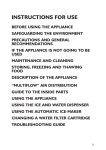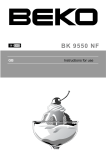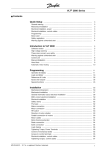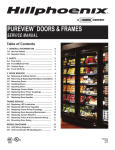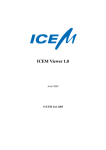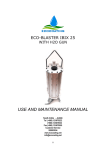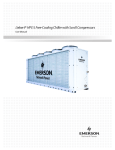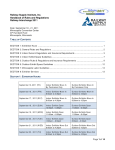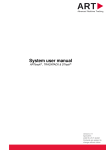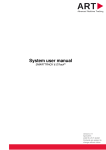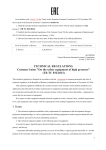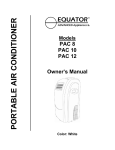Download SPROUTS FARMERS MARKET SPEC REV#3 1-8
Transcript
SPROUTS FARMERS MARKET REFRIGERATION INSTALLATION SPECIFICATIONS Revision #3 (1-8-2015) -1- REFRIGERATION INSTALLATION SPECIFICATIONS Section 1. Scope of Work Section 2. Examination of the Premises Section 3. Change in the Work Section 4. Manufacturer‟s Warranties and Instruction Section 5. Labor and Materials Section 6. Supervision Section 7. Cleaning Up Section 8. Intent of Drawing Section 9. Cooperation with Others Section 10. Opening through Walls, Roof, and Floors Section 11. Bird Screen Section 12. Patching and Repairing Section 13. Equipment Exposed to Weather Section 14. Accessibility of Equipment Section 15. Wiring Diagrams and Equipment Changes Section 16. Display Cases Section 17. Walk-in Boxes Section 18. Drains Section 19. Piping Section 20. Insulation Section 21. Equipment Setting Section 22. Installation Requirements Section 23. Temperature Performance Section 24. Test and Inspection Section 25. Start-up Section 26. Warranties Section 27. Notes for Proposal Forms Section 28. Insurance Requirements Section 29. Refrigeration Controls Installation Guide Appendix A. Sprouts Setpoint Guidelines Appendix B. Site Manager Workflow Appendix C. Sprouts Template Sheets for Condenser Programming & Setup Appendix D. Emerson CT Drive Parameters Appendix E. Lennox IMC Interface -2- I General Notes Sprouts strongly suggest all Contractors that are submitting proposals visit and inspect an open and operating Sprouts store within the region for the project you are submitting a proposal. Check with the Sprouts Project Manager as to which location to visit and inspect. All refrigeration contractors that are invited to submit proposals are professional and reputable contractors. Sprouts expect that the proposals submitted are totally inclusive of what it takes to install the refrigeration, EMS, and cases for this project. During the proposal process, please call with any questions or clarifications prior to submitting your proposals. Generally underground will begin 2 weeks after start of construction for Ground Up projects and immediately for T.I. projects. Typically there is 3 to 4 weeks to install overhead and hang coils in walk-ins. The racks will arrive 1 to 2 weeks before the cases. When the cases arrive there is usually 2 weeks until start up. This is typical but may not hold true for all stores. The Refrigeration Contractor is to inspect all customer supplied refrigeration equipment, cases, and components. Any damage is to be noted on the Bill of Lading and communicated to the Refrigeration Equipment Manufacturer. Within five (5) days of receiving loose parts, the Refrigeration Contractor is to contact the Refrigeration Equipment Manufacturer if any parts are missing. The Refrigeration Contractor is also to inspect cases as they arrive to ensure that all parts & components are on site and then send a list of items needed to the Refrigeration Equipment Manufacturer. The Refrigeration Case Manufacturer will also inspect the cases & components when they arrive on site. Sprouts expects the Refrigeration Contractor to closely coordinate and communicate at all times with the General Contractor throughout the entire project. The refrigeration installation will be inspected and a punch list produced by a 3rd party contractor. . Sprouts requires these punch list items to be completed within two weeks after receipt. These General Conditions, together with the attached specifications and all drawings referred to by the specifications, are intended to illustrate the complete work required under this Contract. Neither the Refrigeration Contractor nor Sprouts shall be responsible for oral instructions. All addenda, corrections or letters issued during the time of bidding shall take precedence over the specifications as written. -3- Section 1. Scope of Work The intent of the drawings and specifications is to provide a complete refrigeration system installation. The Contractor shall provide all labor, material, supervision, tools, and perform all work necessary to accomplish this end. All Contractor supplied materials and devices shall be new unless specified by Sprouts. Materials not specified by name or make shall be subject to approval by Sprouts management. The transportation, unloading, storing, erection or installation, testing and making operable all parts of the Project shall be included under this Contract, at times appropriate thereto. A. The work shall include, but is not necessarily limited to the following: 1. 2. 3. 4. 5. 6. 7. 8. 9. 10. Refrigeration piping, hangers/support & insulation:: Refrigeration Contractor to supply. Condensing units – systems: Furnished by Sprouts. Remote condensers and controls. Furnished by Sprouts. Charging and lubricating systems: Contractor to provide refrigerant. Refrigeration Equipment Manufacturer provides the oil. Adjustments of controls. Terminate wires to the T-stats and sensors, and ensure all alarms are functional. Identification of systems including cases, branch line sets, & EPR valves. For rooftop units, any heat reclaim piping to be in cooperation with the Mechanical Contractor Sprouts. For air handling units, the heat reclaim piping and coil installation, and start-up. Installation of case shelving, and inserts. Make adjustments such as height, relocation of bolts for shelves, etc, Installation & start-up of refrigerated ice machines and all other self-contained cases as shown in plans. Make adjustments as required. -4- 11. 12. 13. 14. 15. 16. 18. 19. Install EPR‟s, EEPR‟s and solenoid valve controls, etc., for walkins and cases. All other installation material, together with all labor and permits as required to do a complete installation and perform the services outlined in this specification as detailed on the drawings. As-built drawings showing any approved deviations from the Contract Documents. Warranty – Ninety (90) days unless otherwise specified. Returning any defective parts/components. Site Manager Setup/Updates (Refer to Appendix B). 17. RTU & S/C Equipment Verisae Paperwork/Refrigerant Charges to be turned into commissioning agent prior to turnover. GreenChill Paperwork to be turned into commissioning agent prior to turnover. Final EMS Programming for Refrigeration, HVAC, & Lighting. Section 2. Examination of the Premises a. The Refrigeration Contractor, before submitting a proposal for this work, shall examine the premises and all conditions thereon and/or therein. The Contractor‟s proposal shall take into consideration all such conditions as may affect the work under the Contract. Section 3. Change in the Work a. Sprouts may make additions, deletions or alterations in the work. b. No changes shall be made or extra work done or paid for unless authorized in writing by Sprouts. Should any change decrease the amount of work, deduction shall be made accordingly in the amount to be paid. Section 4. Manufacturer’s Warranties and Instructions a. No work shall be done by the Contractor, which will void a manufacturer‟s warranty. b.Upon completion of the work, the Contractor shall deliver tothe store at least one copy of all installation and service instructions supplied with the various pieces of equipment. Refrigeration Equipment Manufacturer is to send out (2) binders with installation and service instructions for the Refrigeration Contractor and General Contractor. The Refrigeration Contractor is to give (1) binder to the General Contractors -5- superintendent upon receiving. The Refrigeration Equipment Manufacturer will provide the Sprouts Project Manager with a thumb drive containing this information as well. c. Any work furnished by the Contractor which does not comply with these specifications, or is defective in material or workmanship, will be rejected by written or verbal notice from SPROUTS Project Manager. The Contractor shall start to dismantle and remove such material or workmanship within twenty-four (24) hours of receiving the notice. Such work shall be remade or replaced in accordance with the plans and specifications. d. If any public authority requires any work to be specially tested or approved, the Contractor shall give the proper authorities timely notice of its readiness for inspection. If any such work should be covered over without approval or consent, it must, if required, be uncovered for examination at the Contractor‟s expense. Section 5. Labor and Materials a. The Contractor shall provide all labor, transportation, materials, apparatus and tools necessary to complete everything described, shown or reasonably implied on the drawings or in these specifications. Section 6. Supervision a. The Contractor shall, through competent agents, give proper Supervision of the work. b. Contractor shall furnish the services of an experienced Superintendent who shall constantly be in charge of the Refrigeration Systems, together with all necessary mechanics and laborers required to properly unload, transfer, erect, connect, adjust, start, operate, and test systems. c. Any careless or incompetent worker as judged by Sprouts Project Manager shall be removed by the Refrigeration Contractor when he is notified to do so by SPROUTS Project Manager. d. For the actual fabrication, installation, and testing of work under these specifications, uses only thoroughly trained and experienced workers completely familiar with the items required and with the manufacturers‟ recommendations as to their use. In the acceptance or rejection of the finished installation, no allowance will be made for lack of skill on the part of workers. -6- Section 7. Cleaning Up a. The Contractor shall at all times maintain the Project in an orderly, workman like condition, reasonably clean and free of accumulations of dirt and debris. If the Contractor fails to maintain the Project, the Owner shall have the right to engage others to do so at the Contractor‟s expense. b.The Project shall, in general, be turned over to the Owner in a thoroughly clean and workmanlike condition, ready for the Owner‟s use in every respect. Section 8. Intent of Drawing a. The drawings indicate in diagrammatic form the arrangements desired for principal apparatus, piping, ducts etc., and shall be followed as closely as possible. Use judgment in carrying on the work to secure the best possible headroom and space conditions throughout, to secure a neat arrangement of piping, duct work and equipment, to overcome local difficulties and interferences to structural conditions wherever encountered. b. Any work installed to the contrary, in the opinion of Sprouts Project Manager, shall be relocated and reinstalled at the expense of the Contractor, and at no additional cost to SPROUTS. Section 9. Cooperation with Others a. The Contractor shall schedule their work in such a manner that progress will Harmonize with all trades, and so that all work may proceed as expeditiously as Possible. b. The Contractor shall plan his bid, considering all other trades, to make sure each and every item has been covered. No extras will be allowed for any controversies arising between trades. c. The Contractor will furnish motors and electrical equipment suitable for Electric service and voltages as installed. Section 10. Opening through Walls, Roof, and Floors -7- a. Opening will be provided by others. Contractor shall refer to refrigeration drawings & coordinate with G.C. Section 11. Bird Screen a. All openings through roof occurring in any portion of this contract work shall be provided with bird screen (maximum ¼” screen). Bird Screens must also be installed between the back of the refrigeration cases and the wall. General Contractor is to provide and install the bird screen on all cases backed up to walls except on cases that are part of the return air plenum. Section 12. Patching and Repairing a. Contractor shall be responsible for all patching and repairing relating to work performed, including any fire stops at penetration through fire rated walls, ceilings or floors. Section 13. Equipment Exposed to Weather a. All equipment exposed to weather shall be protected in a manner recommended by the manufacturer and subject to approval of SPROUTS Project Manager, whether indicated on Plans or not. . b. Where possible, weatherproofing shall be by manufacturer, otherwise by Contractor. Section 14. Accessibility of Equipment a. All valves, motors, controls, and other devices or components requiring service, maintenance, and/or adjustment shall be placed in fully accessible position and locations. Provide access doors where required in ductwork of construction, whether specifically detailed or not, to render all such items accessible. Refer to plans for installation location of EPR/EEPR valves & shutoff valves. b. Components requiring access for service, inspection, etc., shall have hinged access openings provided with clamp latches. The use of screws in lieu of hinges or latches will NOT be permitted. Section 15. Wiring Diagrams and Equipment Changes -8- a. Contractor shall pay for any extra charges arising from changes in the control system when the approved Shop Drawing of the Control System is different from that shown on Drawings. Control system shall be taken to include all wiring including power, conduit, switches, relays, starters, etc., required for the operation or control of any or all parts of the HVAC and Refrigeration Systems. b. Contractor shall also pay extra charges for changes in structure, equipment, location, and/or service connections (including plumbing) when caused by installing equipment other than specified or in a manner different from that shown on Drawings. c. Approval by SPROUTS Project Manager of Shop Drawings shall not relieve the Contractor from bearing cost of changes. d. Contractor to have qualified men on the job within 24 hours of being notified. After more than 48 hours of not responding, SPROUTS reserves the right to reassign the contract to a different company. e. Failure to stay within the General Contractor‟s Construction Schedule will dictate a re-evaluation of the refrigeration contractor being considered for future store bid lists. Section 16. Display Cases a. Refrigerated and non-refrigerated display cases will be set and trimmed in accordance with the manufacturer‟s instructions or representative. All cases shall be received at the job site by the refrigeration contractor. If freight damage occurs, it must be so noted on the “Bill of Lading”, and the Sprouts Construction Department immediately notified. No repairs are to be made until authorized to do so by the manufacturer. Cases will be located as per the refrigeration drawings, not the architectural drawings. b. Metal shims (only) will be used to level cases. Case cleaning by this contractor shall include removing all foreign material from cases and vacuuming of drain pan to remove loose material, screws, nuts, labels, stickers, etc. c. The electrical contractor to provide and install all conduits and pull all high voltage wire. However, it shall be the responsibility of the refrigeration contractor to pull all low voltage wire & EEPR wiring and make all final low voltage connections on product refrigeration equipment including the environmental panel, AI panel, light panel, HVAC panel and alarm panel. E.C. to terminate all high voltage wiring. -9- d. Refrigeration line set case penetrations shall be no larger than necessary and will be located in the space designated by the case manufacturer. e. It shall „be the responsibility of the refrigeration contractor to ensure that floor sinks at cases are half in and half out, and that the floor sink grate can be easily removed. Refrigeration contractor to coordinate with plumbing contractor for proper location of floor sinks. f. Case closure panels shall be stainless steel, provided and installed by General Contractor as directed by Sprouts Construction Department. General Contractor also to provide insulated panels at rear load dairy case close-offs. Closure panels will include ALL refrigeration case closures, plenum walls, and openings on top of refrigerated cases. g. Service cases must be sealed on inside & outside and 3-Deck Deli cases must be sealed on the outside joints by Refrigeration Contractor. Caulking must be around entire service cases. Silicone caulking used must color match area being sealed. No clear caulking to be used. h. Install clear acrylic (Plexiglas) divider between like temperatures on separate circuits and insulate partitions on all mixed temperature applications. Dividers and partitions are supplied by the case manufacturer. j. Refrigeration Contractor to provide and install butyl tape to seal both sides of cases at joints. Section 17. Walk-In Boxes a. The evaporator coils will be furnished by the Owner and shall be installed from hangers furnished by this Contractor. Use 3/8” threaded steel rod to support suspended cooling coils. Coils installed in the walk-in coolers/freezers, support coils above ceiling panel with Unistrut. All cooler penetrations are to be sealed both inside and out with foam and silicone sealant by R.C. b. The Fixture Electrician shall install the Refrigeration Equipment Manufacturer supplied micro switch on all walk-in boxes at the top of the door. Micro switch and evaporator coil fans for the freezer boxes shall be wired in back to the rack control. This is to shut off coil fans and pump down the system/circuit with the EEPR within the EMS software when freezer door is opened. No liquid line solenoids are to be used. Section 18. Drains a. All case drains are to be installed by the Refrigeration Contractor. - 10 - Cases will be furnished with a trap, either built-in or supplied loose by the equipment manufacturer, for connection to case drains. b. All case drains will be run to the nearest floor drain with schedule 40 PVC tubing unless other material is required by code. Cleanout unions shall be provided in the most accessible location for cleaning. Drains to be run full size whenever possible. Drain lines to be cleaned and cemented. For threaded fittings, use Teflon tape or pipe dope. If drain lines are ran in return air, Type M hard copper must be used. c. Case line-ups will utilize a maximum of three cases per floor drain Each case to drain independently all the way to the drain hub. Maximum drain runs of 15‟. d. Walk-in cooler drain. Drain will be installed by refrigeration contractor. Drain lines in walk-in coolers must be Type M hard copper. Drain lines and traps will be required from coils in all walk-in coolers to condensate drain outside cooler (per code). e. Drain lines in walk-in freezers and meat cooler must be Type M hard copper. Drain should slope not less than 15 degrees. Drain line shall be wrapped with heat tape and insulated inside of freezer. Meat Cooler drain must be wrapped with heat tape and insulated also. f. Type M hard copper drain lines will be required for coils in all refrigerated prep areas. No drain lines shall be smaller than the coil drain and connection. A copper union shall be installed at the bottom of the pan to allow removal of the drain line. Drain lines shall not inhibit the removal of the drain pan. Provide and install union fitting within 11 inches of the drain pain. g. Heat tape and insulation will be installed and supplied by refrigeration contractor. h. Seal all wall penetrations with expanding foam and silicone caulk, inside and out. i. All walk-in coil drain lines “P” traps shall be outside the walk-in boxes. j. Each walk-in box to drain independently. Do not combine drains from multiple walk-ins. Section 19. Piping a. All piping shall conform to these notes. Anything not covered by these notes must conform to ASHRAE standards. - 11 - b. Piping shall be ACR, hard drawn, Type L with factory sealed ends and sized in accordance with refrigeration schedule and loop piping diagrams. Piping shall be run overhead, as low as possible (above lights & on top of walkins. All other lines shall be underground to avoid drops in the sales area. No exposed refrigeration lines on walls or below ceiling where visible from sales floor. c. Underground piping shall be insulated, installed in PVC and buried directly in trench provided by the General Contractor Trenching and backfilling shall be done by General Contractor. Underground refrigeration lines must be pressurized with 300 psi of dry nitrogen or pressure required by code, whichever is greater, it must sit for a 24 hour period and must not drop more than +/-1 psi when check with the same gauge. Once this process has been verified by Sprouts Project manager or the General Contractor, the refrigeration line can then be buried. Bottom of trench at most distant point from risers shall be a minimum of eighteen inches (18”) below finish floor and graded one inch (1”) per twenty feet (20‟) toward refrigeration rack. Insulated pipe shall then be laid in six inch (6”) bed of sand, and backfilled with no less than eight inches (8”) of washed sand. General Contractor to provide sand and complete backfill. d. Compaction shall be obtained with engineered fill and testing in accordance with General Contractor specifications and soils report. Excess dirt shall be removed from the site by the General Contractor. e. Overhead Suction lines shall be insulated with ¾” Arma-flex and liquid lines shall be insulated with ½” Arma-flex or as noted on plans for high humidity areas, slipped over pipe prior to brazing and sealed at joints. All 90‟s are to be mitered (Refer to Section 20, Item I). Piping buried underground shall be insulated with 1” Arma-flex or equal insulation on both suction and liquid. Pipe shall be installed in a 6” PVC on all underground refrigeration pipes and foam the ends. f. Piping shall be installed per construction drawing. Locate stub ups per construction print and verify with Construction Department prior to floor being poured. Install stub-up four foot above slab grade and protect with 6” PVC sleeve. Paint PVC pipe with brite flourescent colored paint such as Safety Orange Cut PVC to floor grade when fixture is installed. g. P” traps shall be installed on all vertical suction risers over 3‟. For risers over 20‟, install second trap at top of case. Traps shall be one (1) piece, not fabricated from ells, and shall be the same size as the horizontal. “P” traps shall also be provided at the vertical riser in the suction line from each cooler and freezer blower coil. Inverted “P” traps are to be used when branch lines are connected into main suction line runs. - 12 - h. Piping shall be arranged so as not to obstruct easy access to valves, evaporators, coils, compressors, condensers, motor and electrical gear or controls and shall have a minimum seven foot (7‟) high head clearance. i. Overhead piping must be installed in Snap „N Shield pipe hanger made by Cooper B-Line. They must be black in color. Note: Attachment to 2x4 rafters is not allowed. Supported at a maximum of eight foot (8‟) intervals, however no sagging of piping is allowed. Provide sway bracing (lateral & end-to-end) to prevent swing per local code requirements. j. Hyra-Zorb brand clamps or equal with black inserts will be used on all discharge and liquid drain lines including lines to and from the heat reclaim coil and condenser, and a minimum of two (2) clamps once the liquid lines leave the racks. These clamps shall also be installed in all other locations where vibration exists. k. Tubing from one system shall not run through a case or box connected to another system. l. Where branch, coil or case suction lines enter the main suction line, they shall enter at the top. Piping shall be arranged so that refrigerant or oil cannot drain into the coil. m. All welded joints in copper to copper shall be made with silfos with fifteen percent (15%) silver. All joints made copper to brass or steel will be made with Easy Flow with forty-five percent (45%) silver or equal. n. All entry holes (by any trade) for piping to equipment room, display cases or walk-in boxes shall be sealed with insta-foam froth pack or approved equal. Company making entry hole is responsible for sealing same, refrigeration contractor to ensure this is done. Foam is not to be cut back. Foam is to be redone if the initial application excess interferes with either airflow or case parts. Permagum is not acceptable. Penetrations into equipment room where required by code shall be sealed with fireproof caulking. This includes electrical conduit, sprinkler piping and refrigeration piping. The work is to be done with the highest degree of craftsmanship by individual trades o. All fittings to be long radius, wrought copper manufactured by Mueller Brass. p. No 45 degree fittings will be allowed. q. All joining of copper tubing shall be with fittings manufactured for the application. r. Tubing and fittings to be sweat joined shall be cleaned to bright metal before brazing. - 13 - s. No flare fitting shall be permitted where it is possible to make sweat joints. t. Dry nitrogen shall be bled through lines while brazing. Extreme care shall be taken to keep the entire system clean and dry during installation. Construction Department retains the right to cut three (3) welded joints from the system for examination. These joints to be replaced by the Contractor at no expense to SPROUTS. Before making final connection, and prior to charging the system, nitrogen shall be blown through piping to remove loose brazing alloy and dirt. u. All unistrut clamps to be secured with commercial grade nylon stop nuts. v. Refrigerant piping & valves on top of walk-ins shall be identified with legible, permanent marking showing what system it serves. w. System isolation valves on suction & liquid lines shall be installed throughout, including condenser inlet and outlet, for proper pump-down and shut-down procedures. Isolation valves provided by Refrigeration Equipment Manufacturer. x. Appropriate and sufficient expansion loops shall be constructed on all heat reclaim lines to air handlers, and hot water reclaim tank. y. Liquid line take-offs in cases or boxes shall be taken from the bottom half of the branch liquid line. Section 20. Insulation a. All liquid and suction lines shall be insulated continuous from the cabinet of the display case, cooler or freezer coil to the service valve at the compressor. b. All sub cooled liquid lines shall be insulated with ½” Arma-flex and all suction lines shall be insulated with ¾” Arma-flex or as noted on plans for high humidity areas. c. Insulation shall be Armstrong closed cell Arma-flex or approved equal. All suction & liquid lines located outdoors shall have aluminum wrapped insulation. d. All joints to be sealed with #520 Arma-flex glue or equal. f. Discharge lines shall be insulated to OSHA standards with fiberglass insulation one-half (1/2”) thick with properly-fitting elbows. Arma-flex will not be accepted on discharge lines. Provided the discharge lines are a minimum of fifteen inches (15”) from the walkway, the insulation may be omitted. In all stores,provide a - 14 - sign in a prominent location in the machine room which says “Caution-Hot Pipes”. This sign is to be acceptable to OSHA in size and design. g. Any piece of equipment or part thereof that is within fifteen inches (15”) from any walkway and reaches temperatures hot enough to burn human tissue on momentary contact must also be covered. Use sheet fiberglass insulation of proper design to be permanent, neat and effective. h. All insulation in overhead shall run continuous through hangers and shall have metal or rigid plastic sleeves where clamped, except discharge and drain lines. Insulation shall be cut at Hydra-Zorb clamps on discharge, drain and liquid lines.All suction accumulators, or their equivalent, shall be insulated with ¾” sheet Arma-flex. i. Insulation is to be installed in accordance with manufacturer‟s specifications. All 90 degree ells will be covered by making two 22.5 degree mitered cuts and glued. All suction p-traps will be mitered with 22.5 degree mitered cuts and glued also. Any 3/8” piping can use 45 degree mitered cuts. Section 21. Equipment setting a. Compressor racks shall be mounted on vibration isolation pads furnished with the rack. Isolation units shall be lagged to floor and sealed against water intrusion with non-hardening silicone seal. Seismic restraints, when required by local codes, shall be provided and installed and lagged to the floor/I-beam and sealed against water intrusion with non-hardening silicone seal. Contractors to refer to Refrigeration and Structural plans for seismic restraint details and responsibilities. b. If mounted on roof, condenser shall be securely fastened to roof members provided by the General Contractor. If air cooled condensers, clearance from structure must be a minimum of (24”) twenty-four inches to bottom of condenser. c. All equipment and panels should be mounted in location shown on drawings. Section 22. Installation Requirements a. Installation work performed on behalf of Sprouts Farmers Market, work not included in the scope of work and considered “extra”, will not be invoiced to Sprouts without proper authorization prior to the work being done. Labor rate and material mark-up shall be the same as construction rates, as provided as part of the Contractor‟s bid proposal. b. Installation work performed on behalf of equipment manufactures, suppliers, or representatives will be invoiced directly to the requesting party and a copy of each - 15 - invoice forwarded to Sprouts Construction Department. Labor rate and material mark up shall be the same as Sprouts rates. c. Contractor shall provide an experienced service technician familiar with the equipment installed by the Contractor and its operation and adjustment from 5:00 AM to 5:00 PM on opening day. d. Each field installed component part of every system shall be clearly identified with the corresponding system number. (No Dyno tape) Use Brother p-Touch, or equal, labels in a contrasting color.). Cases to be labeled with system number using engraved hard plastic, 1” by 2”, with 3/4” white lettering. Rivet label on each case in upper LH corner. Temporary tags may be used until permanent tags are available. e. Furnish the following, 24” x 36” drawings in picture frame with clear plexiglass mounted on or near each parallel refrigeration rack. For outdoor parallel racks, 11” x 17” laminated drawings are to be attached to the inside of the rack panel. Coordinate with the Sprouts project manager for specific location. 1. As Built Floor Plan Drawing 2. With fixture, rack, and panel locations 3. System Numbers 4. Temperature Probe locations 5. EPR, EEPR, & Solenoid valve locations 6. Any special control locations 7. Showing underground piping/trenches 8. Initial defrost schedule of all systems 9. Engineering Refrigeration Schedule Note: It is mandatory for the refrigeration contractor to provide the engineer of record with marked up drawings indicating any deviations from the plans. f. The Refrigeration Equipment Manufacturer shall supply a sheet metal pocket for the service log book near the parallel refrigeration rack (coordinate with Sprouts project manager for specific location). The Service Log Book will be initiated at start-up and used for each service call, in or out of warranty. The refrigeration contractor shall promptly forward to Sprouts copies of all service calls, in or out of warranty. Section 23. Temperature Performance A. It is the responsibility of the installer to ensure systems are installed in accordance with the manufacturer‟s installation instructions. The discharge air temperatures are to be setup per the refrigeration schedule - 16 - and then optimized by the commissioning agent. All critical temperature refrigerated storage and merchandising equipment used for potentially hazardous food must maintain Food Code temperatures (currently at 41°F) or below at all times (including defrost), and be NSF-7 approved for supermarket operation. Bulk produce (one touch) not applicable. This means all food locations, including above or below lamps, ballast and anticondensate heaters. Section 24. Test and Inspection a. Underground piping shall be pressurized under the GREENCHILL best practices guideline for ensuring Leak-tight installations of Commercial Refrigeration Equipment. This will require 300 psi of nitrogen pressure or pressure required by code, whichever is greater, and must stand unaltered, for a 24 hour period with no more than a +/- 1 pound pressure change using the same gauge. THIS GUIDELINE MUST FOLLOWED NO EXCEPTIONS! The guidelines are available on the GREENCHILL website at http://www.epa.gov/ozone/partnerships/greenchill/downloads/LeakGuidelines.pdf b. The Refrigeration Contractor shall check the SPROUTS Project Manager‟s site schedule and be available for a job walk within two (2) weeks after the installation of major refrigeration equipment. c. Prior to charging systems with refrigerant, the Contractor shall meet Sprouts Project Manager and walk the job for preliminary approval. Contractor shall have inspection covers and case bottom pans open for visual inspection, as well as kick plates for drain inspection. The insides of the cases shall be cleaned by the Contractor prior to this time. d. The Contractor is required to clean all new cases. This includes removing all foreign material from cases and vacuuming of drain pan to remove loose material, screws, nuts, etc. e. Evacuate the system following the GREENCHILL best Practice Guidelines ensuring Leak-Tight Installations of Commercial Refrigeration Equipment standards, while still following all requirements of the EPA, SCAQMD, and any other agency or municipality that has enforcement responsibilities for this project. The guidelines are available on the GREENCHILL website at. http://www.epa.gov/ozone/partnerships/greenchill/downloads/LeakGuidelines.pdf - 17 - f. The Contractor shall schedule the Final Inspection with project manager once all systems are on line and operating normally. Section 25. Start-up a. For all vacuum and refrigerant charging. The refrigeration contractor must follow the GREENCHILL Best Practices Guidelines for Ensuring Leak-Tight installations of Refrigeration Equipment. THE GUIDELINES MUST BE FOLLOWED FOR THE STORE TO QUALIFY FOR THE GREENCHILL CERTIFICATION. The guidelines are available on the GREENCHILL website at. http://www.epa.gov/ozone/partnerships/greenchill/downloads/LeakGuidelines.pdf b. Contractor to check all motors, bearings, fans, and blowers for lubrication and mounting prior to starting. c. Check for proper installation of fan blades on all fan motors-cases, coolers, condensers. d. Contractor to check and tighten all electrical lugs including compressor electrical boxes prior to start-up. e. Check for proper direction of rotation of all fans and all three-phase motors. f. Check oil level on all compressors. Oil added shall be as specified by manufacturer from sealed containers. g. Contractor is responsible for adjusting superheat of all expansion valves and verifying the presence of proper valves after 48 hours of operation. Before attempting to adjust valves, make sure the case is within 10F degrees of its expected operating temperature. Sprouts is requiring contractor to set all superheat during start-up no exceptions. Each case temperature must be within 2F degrees of each other on each system. A representative for Sprouts will be allowed to check up to 10 expansion valves for proper superheat. Contractor is to set superheats after cases are stocked. Start-up technician to coordinate with Sprouts PM and stocker. h. After the expansion valves have been adjusted, check suction temperature eight inches from the compressor suction service valve for proper temperature. The superheated gas at the compressor should be a maximum 20Fdegrees, above saturated suction temperatures of the compressors for low temperature units. For medium temperature units, a maximum 20F degrees, - 18 - i. Contractor is responsible for verifying the presence of the EMS temperature probes in the discharge honeycomb of a case in each subsystem. j. Contractor is responsible for cleaning TXV strainers after twelve (12) hours of operation. k. Change all suction filters, liquid driers, and oil filters after seventy-two (72) hours running. Remove suction filters (30) days after the store opening and leave in compressor rack area for commissioning agent to inspect. l. After seventy-two (72) hours and ninety (90) days of running, acid test the oil in all systems. Provide a copy of test results to Sprouts Facility Manager. m. After start-up and operation has been stabilized, thoroughly leak test system with an electronic leak detector and replace all liquid line driers upon repair of all refrigerant leaks. n. The Refrigeration Contractor along with the Mechanical Contractor shall start up the A/C compressors and air handler including heat reclaim if applicable. HVAC package units are the responsibility of the Mechanical Contractor. The Refrigeration Contractor is to provide EMS control of all RTU‟s. o. The Contractor is responsible for programming the EMS computer systems for proper operation in every respect per SPROUTS specifications. p. Defrost and Temperature Control Specification The Contractor shall supply all defrost and temperature control components as indicated on refrigeration schedule. The length and number of defrost cycles shall be in accordance with case and coil manufacturer‟s recommendations. All defrosts shall be staggered to avoid demand peak. q. During start-up of equipment, the Refrigeration Contractor shall tighten all electrical connections and check all defrost fan, light, and compressor circuits for amperage draw. Remedy if not within design parameters. r. Finals Provide installation and service manuals for refrigerated cases and other equipment in binder form (1 copy) given to the store manager. Contractor must complete Refrigeration log book, start-up records, and GreenChill paperwork and turn in to commissioning agent.. They must provide Store Manager with current defrost schedule and update the Site Manager floor plan The Refrigeration Contractor must also provide basic Site Manager training to the Store Manager. s. Each component of a system shall be identified with the corresponding system number.. - 19 - t. The Refrigeration Contractor is to provide the Refrigeration Equipment Manufacturer with complete marked up As Built refrigeration plans by the turnover date. In addition, the Refrigeration Contractor is to furnish the following As Builts, to be mounted near mechanical equipment (reproduced in such a manner as to not fade with time or light): 1. Floor Plan Drawing 2. With fixture, rack, and panel locations 3. System Numbers 4. Temperature Probe locations 5. EPR, EEPR, & Solenoid valve locations 6. Any special control locations 7. Showing actual underground piping/trenches as installed 8. Initial defrost schedule of all systems 9. Engineering Refrigeration Schedule u. For Hussmann Protocol systems, Hill Phoenix Enviro Pac Distributed systems, and Kysor Warren Distributed systems Refer to the “Start-up” section in the installation and service manual for proper procedures. v. For Hussmann Protocol systems, and Hill Phoenix Enviro Pac Distributed systems. Charging of refrigerant for start up shall maintain a minimum of 15% in receiver, while all systems and compressors are on ,and no systems in defrost. If the system has heat reclaim the receiver shall maintain 30% receiver with heat reclaim OFF. Receiver level shall maintain no lower that 15% receiver level with heat reclaim ON. CONTRACTOR MUST DOCUMENT FULL CHARGE ON REFRIGERATION RACK. If the system requires more than 15% or 30% then the receiver level must be charged to satisfy all system temperatures. If the rack has low ambient valves it will require an additional charge to maintain the receiver level in low ambient conditions. w. After cases, coolers and freezers have a normal operating load, the Contractor shall setup for logging in the controls system. Section 26. Warranties a. Sprouts Project Manager or a representative of Sprouts will perform a walk through after start up with a representative of the installing refrigeration contractor to create a punch list of case installation and refrigeration system installation. Punch list will be provided to installing refrigeration contractor within 15 days of walk. Refrigeration contractor will have 15 days to complete all items noted on the punch list. Once the refrigeration contractor has completed all punch list items notification must be made to Sprouts Project Manager to schedule a second walk through to ensure all punch list items have been - 20 - completed. The refrigeration, mechanical, electrical contractor, and the Commissioning agent must be present at the second walk through to address any unfinished work. Once Sprouts Project Manager has agreed that all punch list items have been completed the 10% retainer will be released. If he punch list items are not complete on the second visit then Sprouts will contract out the work and assume the 10% retainer. b. 365 day walk through to be scheduled by Sprouts Project Manager. c. Warranty period will be begin on the day of grand opening of the store and be effective for 365 days. This warranty shall include any hidden defects in material, workmanship and/or any malfunctioning equipment that requires service. This is to include power outage service calls. This warranty will be enforced unless specified in construction bid. Section 27. Notes for Proposal Forms 1. Due to the various Lease Agreements between the Landlord and Sprouts the break out of cost associated with the installation of the Refrigeration Equipment, Cases and HVAC equipment the proposal process is broken out in five (5) categories. We ask that the Refrigeration Contractors do their best in determining the cost of all material and labor associated with each of these individual tasks. Not all line items on these proposal forms may be relevant to each proposal. Please fill in the line items that are associated only with that particular portion of the job. Following are how the Proposals must be submitted. A) Refrigeration Equipment Install Proposal Form: The cost associated on this proposal is for the materials and labor for installing the rack in association with the refrigeration system, all piping, material and labor. B) HVAC Equipment Install Proposal Form: The cost associated on this proposal is for the materials and labor for installing the rack in association with the HVAC system, all piping, material and labor (only applicable on stores with a built up system with an A/C rack) C) EMS Refrigeration Install Proposal Form: The cost associated on this proposal is for the materials and labor for installing the EMS in association with the refrigeration system. D) EMS HVAC Install Proposal Form: The cost associated on this proposal is for the materials and labor for installing the EMS in association with the HVAC system. E) Refrigerated Cases Install Proposal Form: The cost associated on this proposal is for the materials and labor for installing and setting of the refrigerated cases. - 21 - Section 28. Insurance Requirements The Refrigeration Contractor awarded the Project must have the required insurance coverage as described below. Sprouts must be listed as “Additionally Insured”. Contractor request for payment will not be processed until the required insurance coverage and documents are received by Sprouts. Insurance coverage must be in place prior to Contractor performing any work on this project and not expire until 15 days after Sprouts has opened for business. Contractor Insurance Requirements A. Commercial General Liability - Occurrence Form General Aggregate Limit applies per project per form CG2503 or Equivalent Limits $1,000,000 each occurrence $1,000,000 Personal and Advertising Injury $2,000,000 General Aggregate $2,000,000 Products and Completed Operations Aggregate Including Broad Form Contractual Liability Including Explosion, Collapse and Underground Hazard Jobsite Pollution Additional Insured, per CG2010 11/85 or Equivalent (to include Completed Operations) in favor of Sprouts Farmers Market and any other Designated Party of Sprouts Farmers Market, LLC on a Primary and Non-Contributory Basis. Endorsement must be attached. Waiver of Subrogation in favor of Sprouts Farmers Market and any other Designated Party of Sprouts Farmers Market, LLC B. Automobile Liability - Owned, Nonowned and Hired Automobile Limits $1,000,000 Combined Single Limit Broadened Pollution - When hauling Hydrocarbons or Hazardous Materials as cargo Additional Insured Endorsement in favor of Sprouts Farmers Market and any other Designated Party of Sprouts Farmers Market, LLC C. Umbrella Liability Limits $3,000,000 per Occurrence $3,000,000 Aggregate D. Workers‟ Compensation Limits Statutory Limits Box checked Employers Liability $1,000,000 / $1,000,000 / $1,000,000 - 22 - Waiver of Subrogation included Sprouts and the Landlord need to be named as additionally insured. Sprouts Framers Market shall be the certificate holder. Sample Certificate Only - 23 - - 24 - Section 29. Refrigeration Controls Installation Guide The following information is intended to be a guide for programming, installing, wiring, and setting up the refrigeration control system in the Sprouts stores, for the latest and more detailed instruction on controllers, please refer to Sprouts Templates and Detail Drawings, and the OEM‟s manuals. A. Refrigeration Equipment Manufacturer Requirements 1. Initial programming to include: A program for each controller is supplied with general set-points,input and output assignments, pressure control settings, defrost and sensor control settings per Sprouts set point guidelines. Condenser programming to be setup for TD Control Strategy. 2. Mounting and terminating all rack inputs which will include discharge and suction pressure, liquid temperatures, liquid level and rack alarm 3. The refrigeration controllers, and associated boards, will be mounted by the Refrigeration Equipment Manufacturer 4. The Refrigeration Equipment Manufacturer will be responsible for factory installation of the rack controls. B. Contractor Requirements 1. The Refrigeration controllers are networked together to the building HVAC controller at the Power wall, the network switch will be located at the Power wall. The alarm annunciator will be the HVAC controller. C. Installation 1. All low voltage wiring shall be in metal conduit where subject to mechanical damage and at levels below 10ft or located on any part of the sales floor area. Conceal raceways except within mechanical, electrical, or service rooms. Maintain minimum clearance of eight inches between raceway and high-temperature equipment. Seal top ends of vertical raceways. - 25 - 2. Low-voltage wiring shall meet NEC Class 2 requirements. Sub-fuse lowvoltage power circuits as required to meet Class 2 current limit. NEC Class 2 (current-limited) wires not in raceway but in concealed and accessible locations such as return air plenums shall be UL listed for the intended application. 3. Install Class 1 and Class 2 wiring in separate raceways. Boxes and panels containing high-voltage wiring and equipment shall not be used for lowvoltage wiring except for the purpose of interfacing the two through relays and transformers. 4. Run exposed Class 2 wiring parallel to a surface and tie neatly at 10 ft intervals. Use structural members to support or anchor plenum cables. Do not use ductwork, electrical raceways, piping or ceiling suspension systems to support or anchor cables. 5. Include one pull string in each raceway 1 inch or larger 6. No changes to the scope of work shall be permitted without the permission of the Sprouts project manager. 7. Secure raceways, and conduits, with clamps fastened to structure and spaced according to code requirements. Raceways and pull boxes shall not be hung on or according to code requirements. Raceways and pull boxes shall not be hung on or attached to ductwork, electrical raceway, piping, or ceiling suspension systems. D. Programming 1. Point Naming: Name points as shown on the equipment points list. Must include name, system number, board and point. If sensor control or Combiner must have name and board and point 2. Provide system programming necessary for system operation under Sprouts Set point Guidelines (See Appendix A) 3. Refrigeration Contractor must work with Sprouts IT department. The Refrigeration Contractor is to pull cable between the alarm RO point and the burglar alarm panel and ensure that the alarm company lands cable in the burglar panel. The Refrigeration Contractor is to work with the alarm company to ensure that Guardian can receive refrigeration failure signal prior to product being loaded in cases or walk-in boxes. - 26 - 4. Refrigeration Contractor must commission all VSD drives on condenser and air handlers. All VSD programming and control programming must be complete and to Sprouts Specifications. 5. Refrigeration Contractor must install Site Manager and a Site Manager Floor Plan indicating if the cases are in alarm, defrost, or running at designed temperature on store managers PC. Lighting overrides must also be provided on the SiteManager Floor Plan. Contractor must provide a training session with the store manager on the operation of the system. (See Appendix B). F. Communication Wiring 1. Each run of communication wiring shall be a continuous length without splices. If splices are found contractor will be required to repull cable. 2. Label all communication wiring to indicate origination and destination. 3. Install communication wiring in separate raceways and enclosures from other class 2 wiring. Do not exceed maximum cable length, specified by Energy management manufacturer specifications. 4. Communication wiring shall be class 2 low-voltage wiring. G. Wiring and Hardware Identification 1. Label all wiring and cabling, with system number or termination number at each end of wiring. 2. Label each control component with permanent labels. 3. Label all room, offices, and sales floor temperature sensors. 4. Label all hardware cabinets and enclosesures that contain EMS devices. H. Control system Testing. 1. Calibrate all devices that require precise reading. Example all pressure transducers, humidity sensors, and light level sensors. 2. Verify that all control wiring is properly connected, verify that are terminations are tight. 3. Verify that all output devices such as relay point, solenoid valves, and electronic stepper valves are functioning properly. - 27 - 4. Check each alarm with an appropriate signal at a value that will trip the alarm. The alarm buzzer must be activated at the front of the store and the alarm company must be notified that they have received a signal. 5. Verify that system operates according to sequences of operation. Simulate and observe each operational mode by overriding and changing inputs and schedules. I. Temperature Sensors 1. All cables must be labeled with system number and type (temperature or termination sensor). 2. Refrigeration Equipment Manufacturer must provide detailed board and point sheet located in the Analog Input panels. Any changes made by the contractor must be clearly documented. 3. Install all sensors according to manufacturer‟s recommendations. 4. Mount outdoor air temperature sensors on roof, facing north with light level sensor to RTU. The sun shield must be installed over the temperature sensor. This is the outdoor temperature sensor for the HVAC controller not the air-cooled Condensers. 5. Walk-in box sensors will be mounted in the return air of one of the coils. Locate sensor at height of bottom of the evaporator, centered between the evaporator and the wall, no more than one foot from the evaporator. Use CPC walk-in box sensor, J box should be located on top of walk-in box. 6. All cables going to fixture must be installed in conduit not strapped under the case with wire ties. 7. Cable that is not on the sales floor must be bundled together and strapped every three feet. The cable bundle must be strapped to the ceiling truss or girder, not to refrigeration lines, plumbing lines, or sprinkler pipes. 8. All sales floor cable must be concealed in conduit. Underground conduit will be provided and installed by General Contractor‟s electrician. 9. Cables must be a continuous run with no splices. NO EXCEPTIONS! 10. From AI panel a single pair cable shall be pulled for each temperature sensor to cases and walk-ins. All refrigerated cases and walk-in boxes will require a temperature sensor. Muti-conductor wire will not be accepted. - 28 - J. Defrost Terminations 1. Run defrost termination for systems as specified on the refrigeration drawing and point sheet. A single cable shall be pulled for each system and walk-in from A/I panel to fixture. 2. Terminate Klixon, t-stat, or pipe mounted temperature probe from case to defrost panel. All stats to be wired in series no voltage to be used. 3. Medium temperature MD meat & fish cases will require defrost termination by temperature. K. Door Switches 1. Door switches should be magnet break type, no moving parts. Door switches will be provided by the Refrigeration Equipment Manufacturer and installed on all walk-in boxes. Micro switch and evaporator coil fans for the freezer boxes shall be wired in back to the rack control. This is to shut off coil fans and pump down the system/circuit with the EEPR within the EMS software when freezer door is opened. No liquid line solenoids are to be used. 3. A single pair cable shall be pulled for each walk-in, from box to A/I panel nonvoltage. L. Variable Speed Drives 1. Sprouts shall provide all VSDs/ VSD enclosures and bypass assemblies, sensors, IO boards, transformers and necessary refrigeration controllers. 2. Installation contractor shall supply all conduits, unistrut, fasteners, line voltage conductors and connections, control wiring and CAT5 network communication cables as indicated on plans. 5. Where controls and control system elements are permanently installed, installation must be made in a manner that does not obstruct refrigeration maintenance and service activities. Also VSDs and bypass panels shall be mounted so that access doors can be opened at least 90 degrees. 6. Line Voltage conductor must be run in metallic conduit. Line and load side of wiring must be in separate conduit. Conduit provided by Electrical Contractor. 7. No low voltage cables shall be run in same conduit as line voltage. 8. Low voltage communication wiring shall be run with no splices. - 29 - M. Air Cooled Condenser Fan VSD TD controls installation 1. For air-cooled rooftop condensers that are 2 Fans long or longer condenser fan #1 shall always be the fan closest to the refrigeration manifold. Fan #2 shall be the fan immediately adjacent to fan #1. Fan shall be identified 3 through 4,5,6, etc. Continuing this odd/ even pattern. Fan 2 shall be identified as the first fan on the right manifold side. Fans shall be identified 3 through 6 continuing this odd/even pattern. Note fans will only cycle in bypass. If the condensers is running in normal VSD operations all fans will ramp at the same time. Refer to Sprouts template sheets for programming and setup. (See Appendix C) 2. Air-cooled fan rooftop condensers that are 1 fan wide by 4 fans long or longer, condenser fan #1 shall always be the fan closet to the refrigeration manifold. Fans shall be identified 2, 3, 4, etc. moving away from the manifold. 3. Make wire connections at VSD so that the incoming line feeds from the load side of the condenser disconnect, provides incoming line power to the VSD, and VSD line output power conductors are connected to the air cooled condenser fan motor distribution block. The CPC relay output will close the fan contactors the contactor will be equipped with auxiliary contacts that will connect to the forward run on the VSD. Wiring must be routed inside watertight conduits. Motor disconnect to be on the line side of the drive. 4. Refer to NEC and local electrical codes and regulations for the correct size of conductors. In some cases a larger conductor size may be required to avoid excessive voltage drop. Also follow VSD manufacture specifications. 5. All network wiring running to CPC boards located in the condenser control panel must be in separate conduit. 6. Install a temperature sensor on each air cooled condenser being fitted with a VSD in a protected location on the air cooled condenser. Sensor provided by Refrigeration Equipment Manufacturer. Sensor shall be mounted to the close to the refrigeration manifold. The sensor shall be out of direct sunlight,in free air circulation and some distance from source of warm air, so that it always maintains an accurate ambient air temperature. Do not locate sensor near equipment room makeup or exhaust openings, vent stacks for heating appliances, and HVAC exhaust duct opening. See image below: - 30 - 7. Install a temperature sensor on each dropleg pipe at condenser outlet, cover sensor with weather-tight Arma-flex .. Dropleg sensor supplied by Refrigeration Equipment Manufacturer. 8. Install a 500 psi pressure transducer on condenser drop legs or return legs this will be the control transducer for the TD strategy. Transducer must be installed upstream of any head pressure control valves. Transducer supplied by Refrigeration Equipment Manufacturer. 9. Follow Sprouts Setpoint Guideline template for proper setting. 10. For 540 RPM motors, program as staged pairs per Sprouts setpoint in template guide. 11. If refrigeration rack is equipped with low ambient valves. Set the inlet pressure regulator on the dropleg to 65F degree condensing temperature. N. VSD on Evaporative Condensers 1. Provide and install line voltage wiring and connections between the VSD and condenser enclosure as required by the NEC and VSD manufacturer‟s guideline. The VSD must be connected to the building electrical system ground. 2. Make wire connections at VSD so that the incoming line feeds from the load side of the disconnect provides incoming line power to the VSD, and VSD line output power conductor are connected to the fan motor contactor. The fan motor contactor will close when relay output is energized, the contactor will require - 31 - auxiliary contactor that will connect to the forward run on VSD. Motor disconnect to be on the line side of the drive. 3. All control cable must be wired separately from high voltage wires and must be in conduit. 4. Install one ambient temperature sensor on building. Sensor must be shielded from the sun. Install one humidity sensor. Both sensors should be facing north away from condenser exhaust. It should be located a distance from any potential source of warm air. Locations near equipment room exhaust opening, vent stacks for heating appliances, and HVAC exhaust duct should be avoided. 5. Install a temperature sensor on each dropleg and wrap with weather tightArmaflex. Dropleg temp sensor supplied by the Refrigeration Equipment Manufacturer. 6. Install a 500 psi pressure transducer on condenser drop legs or return legs this will be the control transducer for the TD strategy. Transducer supplied by the Refrigeration Equipment Manufacturer. 7. Follow Sprouts template for Evaporative condenser programming. 8. Commission VSD for proper operation in bypass and back to VSD. Verify all parameter are programmed correctly. Commissioning agents will test for proper operation. O. EMS/ Building Controls 1. Program all air handler and rooftop unit to Sprouts Setpoint Guidelines. The network switch must be located at the powerwall. 4. Refrigeration Contractor must design a map of all RTU communication wires and mount on wall near building controller. 5. The EMS contractor must work with the mechanical contractor on installation of CPC controls on all roof top or remote fan coil units. The Mechanical contractor will start up all roof top units or remote fan coil units and install a temporary thermostat in the return air of the unit. When the unit is determined fully operational by mechanical contractor the refrigeration EMS contractor will then take full control of the unit and install all CPC components. P. Lighting - 32 - 1. The following lights will be controlled. Sales lights, case, canopy, signage, inside perimeter, security, parking lot and wall pack lights. See Appendix A for parameters. 2. The inside 2/3 lights and 1/3 lights will be controlled by indoor light level sensor. Lighting control should be staged so that 2/3 lights is first setting and 1/3 lights is second setting. Follow Sprouts setpoint guidelines for proper times. Note indoor light level sensor will vary on each store. The foot candle should be at 90 with the lights OFF. Make adjustments on controller to obtain this setting. 3. An outdoor photocell shall be installed for the outdoor lights. The photocell must be positioned to the north so that sunlight cannot shine directly into the photocell. It must be installed in a position on the roof that places it at a height which allows it see the horizon (actual light) as opposed to the parapet wall (reflected light). 4. All lights must be set up to fail ON in the event of a board failure. 5. All lighting must be installed with a override buttons that will be controlled by the CPC controller via a digital input (DI). Override buttons must also be on SiteManager Floor Plan. Sign and Return these pages with your Proposal. Company Name: Signature:________________________ Date:________________ Name:_______________________ - 33 - APPENDIX A - 34 - APPENDIX A - 35 - APPENDIX B Site Manager Workflow Requirements of the Refrigeration Contractor for Site Manager to work when IT has established connection for the store (1) Refrigeration Contractor to verify all Probe location between programming and Hill Phoenix Drawings Sheet R1 match (2) Refrigeration contractor will need to enter the store IP address into both controllers, RX300 on the rack and the BX300 on the power wall (3) Refrigeration contractor to contact Sprouts to test connection once IT has established the connection (4) Once test is complete refrigeration contractor is to use the manager computer and connect to HTTP;//sproutssm.ectsolutions.net/emerson/ login to the IP address and the Site Manager will begin to read the system For Hussmann Projects we will need to contact them and request the E2 RX controller set-point files and the Specific floor plan they list all the sensor probes, we can use the fixture floor plan from the Architect to establish the store floor plan. - 36 - APPENDIX C Condenser Task: 1 Thru 7 - 37 - APPENDIX C Condenser Task: Continued - 38 - APPENDIX C Control Techniques 1 Thru 6 - 39 - APPENDIX C Control Techniques Continued \ - 40 - Loop Sequencer 1 Thru 7 APPENDIX C - 41 - Loop Sequencer Continued APPENDIX C - 42 - APPENDIX D - 43 - APPENDIX D - 44 - APPENDIX D - 45 - APPENDIX D - 46 - APPENDIX D - 47 - APPENDIX D - 48 - APPENDIX D - 49 - APPENDIX D - 50 - APPENDIX D - 51 - APPENDIX D - 52 - APPENDIX E - 53 - APPENIX E - 54 - APPENDIX D - 55 - APPENDIX D - 56 - APPENDIX D - 57 - APPENDIX D - 58 - APPENDIX D - 59 - APPENDIX D - 60 - APPENDIX D - 61 - APPENDIX D - 62 - APPENDIX D - 63 - APPENDIX D - 64 - APPENDIX D - 65 - APPENDIX D - 66 -


































































